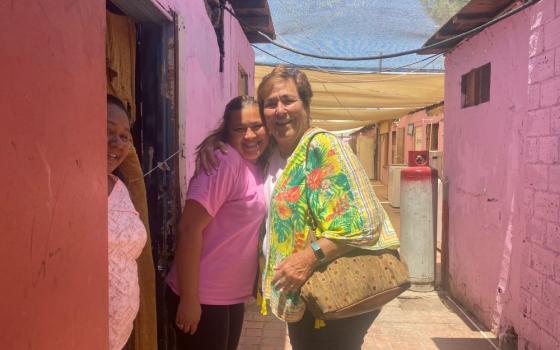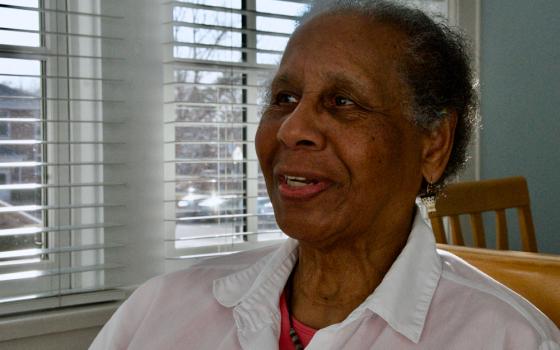Armchair Vaticanologists everywhere grasp that all departments of the Holy See may be created equal, but when it comes to real-world influence, some are obviously more equal than others. Near the bottom of the pile are the pontifical academies, which are scholarly bodies devoted to topics such as the sciences, Mariology, the fine arts and archeology.
Even the most seasoned Vatican-watcher probably would struggle to tick off all 11 of these outfits. (Try it yourself, right now, without looking). No disrespect intended, but the academies tend to be populated by eggheads invested in somewhat arcane questions, and their debates, while fascinating, don't necessarily have any direct correlation with Vatican policy. After all, the Pontifical Academy of Sciences has been hammering away in favor of GMOs for years, and that's still not the official line.
This background is by way of saying that one should not make too much of a recent contretemps at the Pontifical Academy for Life, because it's not really as if the fate of the Vatican hangs in the balance.
Yet the dust-up is nevertheless worth pondering, primarily because it captures three recurrent tensions in Catholic life, with consequences far broader than the immediate future of one pontifical body:
- European vs. American sensibilities vis-à-vis the "life issues"
- Prophets vs. team players
- Dialogue vs. debate in engaging those who don't share church teaching
After a brief review of the controversy, I'll unpack each.
* * *
Founded in 1994 by Pope John Paul II, the Pontifical Academy for Life is made up of roughly 70 intellectuals, medical experts and pro-life activists from around the world. Members are named by papal appointment, but of course it's not as if Benedict XVI personally agonizes over the roster. In practice, the academies are fairly self-perpetuating, with existing members and the staff flagging potential additions. The academy is presided over by a Vatican prelate with a small staff and led by a six-member governing council.
Through the years, the membership of the Academy for Life has been a cross-section of fairly ordinary Catholic figures, along with some of the most outspoken -- critics would say "extreme" -- voices in the pro-life world. That contrast is always a potential source of heartburn, and, from time to time, it flares into open conflict.
In 2009, for instance, the then-president of the academy, Italian Archbishop Rino Fisichella, criticized a Brazilian bishop for declaring excommunications for the mother and doctors of a 9-year-old girl who had an abortion following sexual abuse by her stepfather. In a controversial essay for the Vatican newspaper, Fisichella argued the bishop had spoken too quickly and that the emphasis should have been on compassion.
In some quarters, Fisichella's essay was interpreted as justifying abortion under certain circumstances, and a number of academy members voiced strong public protest. One year later, Benedict XVI made Fisichella the first head of the Pontifical Council for Promoting the New Evangelization, sparking debate that continues to this day over whether the transfer was a vindication or a slap on the wrist.
Three years later, Fisichella's successor now finds himself in the firing line.
The controversy erupted in early May when several academy members, led by Austrian Catholic philosopher Josef Seifert, once again suggested its leadership should go, this time in protest over two recent conferences organized under the academy's aegis -- one in February on infertility, another scheduled for April on stem cells, which was later cancelled. Seifert and other critics objected that both events featured speakers who don't share Catholic teaching, thus creating the risk of scandal and confusion.
Seifert penned a six-page open letter to Spanish Bishop Ignacio Carrasco de Paula, an Opus Dei member and the current president of the academy, to report "enormous concern" that the academy is losing "its full and pure commitment to truth."
Especially by the standards of the Vatican, where the cult of the bella figura usually means keeping internal tensions under wraps, this dispute has turned fairly nasty. On background, sources within the academy have groused to reporters that the place has been "paralyzed" by a small but vocal minority; Cardinal Gianfranco Ravasi of the Pontifical Council for Culture, openly and on the record, has all but called the critics "fundamentalists."
Sources say it's unlikely anyone's head will roll this time around. Carrasco de Paula has already apologized privately and sent a soothing letter to members, and he'll be 75 in October anyway.
Apart from the particular personalities and history, the situation can be framed in terms of three big-picture tensions.
European vs. American sensibilities
Anyone who's spent time in Catholic circles on both sides of the Atlantic has noted a clear contrast with regard to the "life issues."
In a nutshell, issues such as abortion and gay marriage generally don't command the same pride of place in European Catholic consciousness that they do in the States. Even the most conservative European Catholic is inclined to see such matters as important and non-negotiable but not necessarily as "get out of bed thinking about them" concerns. Their passion is often directed elsewhere -- opposition to the EU, for instance, or concern about Islamic immigration and the "clash of civilizations."
In part, this is because the political climate is different. Abortion and gay marriage are "in play" in the States, meaning they're not settled politically, unlike much of Western Europe. In Italy, for instance, voters approved a referendum in 1981 to uphold the legality of abortion in the first trimester, and it's been more or less off the table in Italian politics ever since.
As a result, pro-life Catholics in Europe tend to see themselves as upholding a minority viewpoint unlikely to be translated into law anytime soon. They generally aren't as aggressive politically, and they're also less conflicted about public exchanges with people who don't share Catholic teaching, because they're not as worried about the direct political fallout.
Over the years I've been at any number of events in Rome that attracted Vatican-friendly folk from both Europe and the States, and this contrast often comes up. Even the most conservative Europeans sometimes accuse the Americans of myopia, while Americans accuse the Europeans of surrender.
To some extent, this background might not be entirely applicable in handicapping the tensions at the Academy for Life. After all, the ringleader of the current opposition, Seifert, is an Austrian (albeit one who spent part of his career in Texas, at the University of Dallas and his own International Academy of Philosophy in Irving), just as Fisichella's biggest critic three years ago was a Belgian: Monsignor Michel Schooyans, a retired professor at the Catholic University of Louvain.
Yet in terms of the academy's staff, Carrasco de Paula is a Spaniard, while his top aide, Monsignor Renzo Pegoraro, is an Italian, and the other three senior officials include two Frenchmen and an Italian. For sure, no one can accuse Carrasco de Paula of being "soft" on life issues; when IVF pioneer Robert Edwards was awarded the Nobel Prize in 2010, Carrasco de Paula objected because the technology leads to the destruction of embryos. That said, figures such as Carrasco de Paula nevertheless move in the broader culture inside the Vatican, which tends to reflect basic European Catholic sensibilities.
There have been some recent efforts to bring a sharper American edge on the life issues to Rome. On Sunday, for instance, a "March for Life" took place from the Colosseum to St. Peter's Square, joined by American Cardinal Raymond Burke and modeled on the March for Life held each year in the States on the anniversary of the Roe v. Wade decision.
It remains to be seen to what extent such efforts could take hold, especially if the broader political climate in Europe remains the same.
Prophets vs. team players
Another common Catholic tension, which one can also see underneath the current row at the Academy for Life, pivots on the extent to which one is inclined to give the church's official leaders and structures the benefit of the doubt -- as opposed to pushing those leaders and structures towards one's own vision of the authentically Gospel-based position.
For some Catholics, the idea of sentire cum ecclesia, "thinking with the church," is a core virtue, and among other things, it implies striving to be in communion of heart and mind with the hierarchy. Other Catholics are less inclined to such deference, believing the church is best served when they push its leadership to have the courage of their convictions.
It's the difference between prophets and team players. Temperamentally, prophets are inclined to rock the boat, team players to calm the waters.
That tension pops up everywhere, and it's long been visible at the Academy for Life.
For instance, some pro-lifers, including some members of the academy, object to the use of neurological criteria to establish death (so-called "brain death"), arguing that it enshrines a functional standard over the inherent dignity of life. The debate has practical implications, especially for organ transplantation. Even though the use of neurological criteria is now more or less settled Catholic teaching, approved by various Vatican agencies and by Pope John Paul II himself, some members of the academy continue to dissent, even organizing parallel meetings alongside academy events to voice their opposition.
That, of course, is precisely the sort of thing prophets do, speaking what they see as truth to power. Team players tend to think that once Rome has spoken, the case is closed -- or, at least, one ought to presume some wisdom in whatever Rome has said and think carefully before challenging it.
In theory, the authentically Catholic stance is both/and. The idea is that both prophets and team players have their place, and the instincts should be complementary rather than antagonistic. In practice, of course, it doesn't always work out that way, and the Academy for Life now seems like something of an experiment in whether the two can be brought back into alignment.
Debate vs. dialogue
Finally, there's a root contrast in Catholic psychology with regard to how the church engages the outside world, especially those who don't share Catholic teaching. One instinct puts the premium on argument, striving to convert the church's opponents if possible, but at a minimum making it clear that they're on the wrong side; the other instinct wants to open dialogue and to seek understanding, on the theory that doing so is a prelude to changing hearts and minds.
Once again, these two postures are supposed to complement one another. In 1991, the Pontifical Council for Interreligious Dialogue published an entire document to that effect titled "Dialogue and Proclamation," vis-à-vis interfaith relations. The fact that a primary contributor to the document, the late Belgian Jesuit Fr. Jacques Dupuis, later fell under Vatican suspicion is one measure of how dicey the transition from theory to practice can sometimes be.
A common flashpoint is the question of whether to offer a platform to people who hold different views in church events. Debaters generally think that's a bad idea, on the grounds that it weakens the clarity of the church's message and sends misleading signals about the possibility of compromise. Dialogue folks, on the other hand, usually say the church should be in conversation with everyone. That's what it means to be a "church," they believe, as opposed to a "sect."
The tension is clearly in play in the current disputes at the Academy for Life.
Schooyans, for instance, one of the more vocal in-house critics, has said inviting speakers to a Vatican event who part company with Catholic teaching on matters such as in vitro fertilization or embryonic stem cell research means allowing them to "falsify the doctrine of the church in respect to human life." Yet French Fr. Scott Borgman, a member of the academy's staff, has said an essential part of its mission is "creating dialogue with science and not closing ourselves off."
Ravasi, president of the Vatican's Pontifical Council for Culture, struck a similar note in a recent interview with the Catholic News Service. Ravasi is the architect of the Vatican's "Courtyard of the Gentiles" project, designed to foster exchange between the church and non-believers.
Asked about the dust-up at the Academy for Life, Ravasi defended a stance of listening to the opinions of those who disagree with the church, saying fear of such exchange often occurs when someone "doesn't feel capable of defending or justifying his own reasons." Ravasi pointedly said such dialogue presumes "an identity that's serious and well-formed, not just fundamentalist."
The Academy for Life can't be expected to settle these three tensions for the whole church. Nevertheless, it will be fascinating to watch them play out, because many Catholics experience the same struggles, sometimes in their environments, sometimes in themselves.
[John L. Allen Jr. is NCR senior correspondent. His email address is jallen@ncronline.org.]




